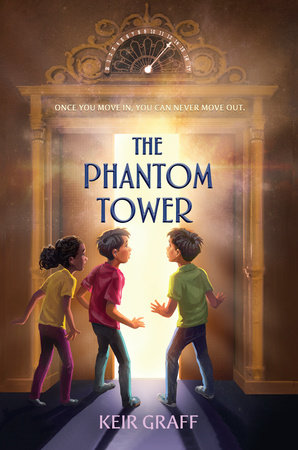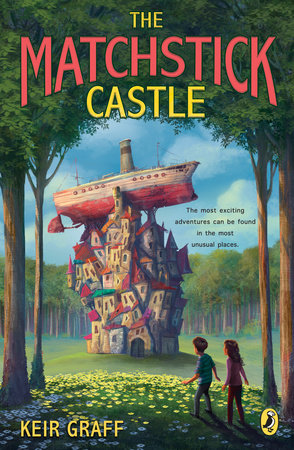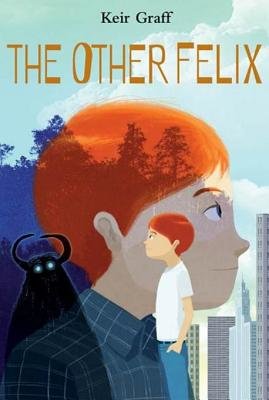Help! My Editor Is a Fifth Grader!
by Keir Graff
The key to any good idea is not really thinking about what you’re getting yourself into. For instance, if I’d stopped to think about how fast fifth graders read, I might never have said: “What if I workshopped my next middle grade novel with a whole class of kids?”
Fortunately, I didn’t think it through, and in an even better stroke of luck, Ms. Vitkus, my younger son’s fifth grade teacher, enthusiastically seconded the notion before I could have second thoughts. In January 2017, I sent her the first three chapters of my novel in progress, The Phantom Tower, to share with the 34 students in room 322 of Walt Disney Magnet School in Chicago.
Over the next month, Ms. Vitkus posted each new installment on her classroom’s password-protected web page. During breakfast, the students read my drafts on their iPads, then wrote down their responses, which Ms. Vitkus collected and sent home with my son. (I think he may have been relieved that he didn’t have a character named after him in this book, as he did in The Matchstick Castle — although his friends did recognize that Brunhild Tower in The Phantom Tower is modeled on the building in which he lives.)
Once a week, I visited the class to read aloud and lead a discussion in person, asking the kids what they liked, what they didn’t, and what they felt could be improved. I told them that, while compliments were welcome, the real purpose of the exercise was to improve the book, and they took that mission to heart. Sure, they were excited to have a Real Live Author in their midst, but any sense of awe soon wore off: After a few visits, I was Just Another Grown-Up.
If I thought they would be too intimidated to be honest, I needn’t have worried.
While I was quickly reassured that the book was working — they liked the premise, loved my cliffhanger chapter endings, and thought the sibling chemistry between identical twins Colm and Mal was authentic — they didn’t hesitate to tell me when I was giving too much detail, or too little, or going too slowly. They bugged me about repetition of words and ideas; I thought I was giving them necessary clues, but they didn’t need many reminders.
Some notes went against conventional middle grade wisdom: They wanted less dialogue, more description, and, in the words of one reader, “It would be better with more complicated words.” True, this was a gifted class, but I thought it was a fascinating reminder that while I strive to write with clean, uncomplicated language, many in my audience are students whose teachers are constantly challenging them to stretch their own writing vocabulary — and they wanted me to do the same.
Some suggestions sounded just like something my adult editor would say, telling me to “go into more detail” about something or to raise the stakes for my characters. Comments and criticisms ranged from general to specific (“Page 194 is amazing. I love backstory!”), serious to silly (“Add a duck!”), and from completely unworkable to surprisingly useful. I can think of at least three significant ideas that I incorporated in later drafts.
Some readers even keyed in on larger themes. One student warmed my heart with her observation: “I like how death plays an important role in the story.”
I had most of the book written, but not all, and soon I found myself racing to keep up with the kids, finishing chapters the day before submitting them to the class. Knowing I had an impatient audience helped me hit my deadlines, because they seemed hooked on the book and I didn’t want to let them down.
When it was finally done, we had one last wide-ranging discussion during which I took copious notes. When I added all of their daily responses and typed the whole thing up, I had a document almost 10,000 words long that helped me see which responses were shared by several students and which were outliers. (Every kid in the class wanted more of supporting character Teddy, except one tough cookie who wanted to kill him off!)
Since then, I’ve kept in touch, sharing cover sketches and giving the students updates on the interminably long publishing process. This past spring, more than a year after we started, I visited the now sixth graders to deliver advance copies and pizza, both of which were consumed with great enthusiasm. I’m hoping to see many of them again this September, when we kick off the nationwide tour at a bookstore in Chicago.
After receiving their copies of the final version of the story, some students wrote short reviews that will be used in the official marketing campaign. But my favorite reviews came while the book was still in its first draft and were written by the kids who had front-row seats to its messy creation. At the bottom of her notebook paper with her responses to the day’s reading, Claire D. (who also told me it was “Like nothing I have ever read before”) wrote, “PS, this book is amazing!”
I know some authors who worry that hearing too many opinions will drown out the most important voice in their head. But for me, hearing from 34 readers was the perfect way to make sure I wrote the book they really wanted to read.
-
Books by the Author:
-
The Phantom Tower
Preorder from:The Other Felix
Preorder from:



